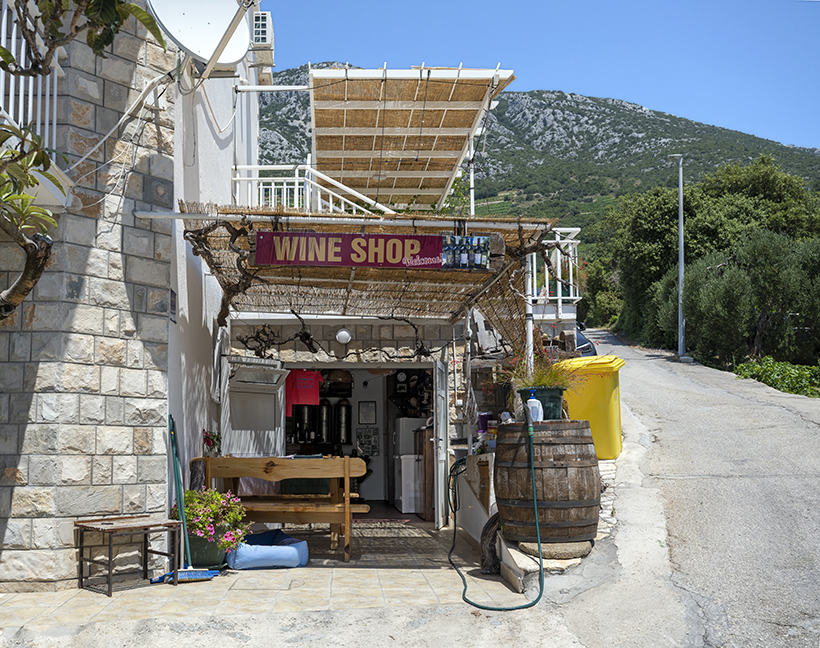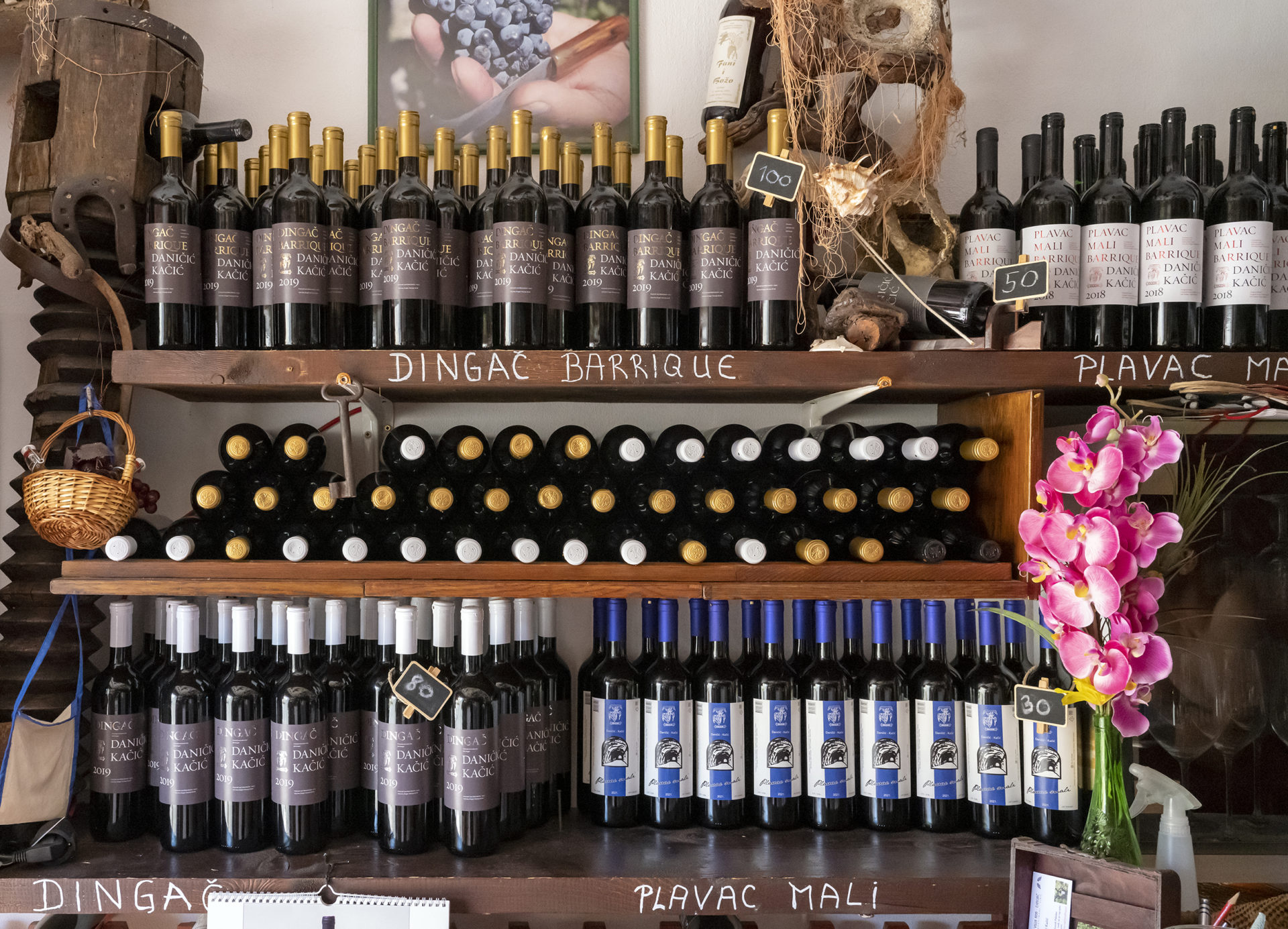Most tourists don’t visit Dalmatia specifically for its wine. Sure, they’ll enjoy local vino at restaurants, and they might even visit the occasional winery if it’s not too far from the beach or if Anthony Bourdain ate and drank there. But driving (yes, they’d need a car) an hour to the middle of nowhere to taste some unknown wine under a blazing sun and the confused gaze of a producer who lives at the end of an unnamed dead end, answers neither email nor phone, and probably speaks two words of English, lands pretty low on their bucket list. Old men with scruffy clothes in musty sheds aren’t Instagrammable. And yet, while people flock to California to taste overengineered Zinfandel in overdesigned tasting rooms (or also under a blazing sun), there’s one peninsula in Croatia that silently produces reds from the related Plavac Mali varietal under appellations famous in the whole of former Yugoslavia and beyond, benefiting from outstanding exposure and yielding juices of unparalleled concentration that sometimes fetch prices higher than even their American cousins. The region is called Pelješac, and some of its localities, such as Postup or Dingač, command the respect of any serious lover of Croatian wine. They deserve yours too!
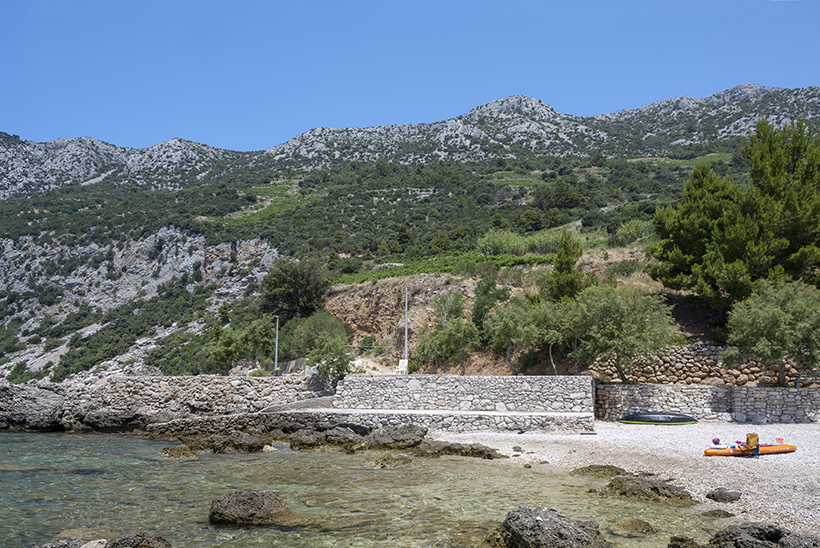
The second largest peninsula in Croatia, Pelješac is covered with vineyards starting in Ston near the mainland and stretching all the way to Orebić near the tip. To be more precise, Pelješac is dominated by hills, karst fields, and vegetation, but vineyards nestle in the bowls of fertile limestone soil between the mountain ridges and spread down the steep slopes of the southern coast. Don’t expect vast expenses of vines: most parcels are small and limited by the constraints of the terrain.
In the center of the wine-growing region sits the village of Potomje, where many small family wineries will gladly give you a taste of their production in small tasting rooms-cum-shops This is how we found ourselves knocking at the door of Matković Winery, on our way to another nearby vineyard. Tourists need not worry; Matković may be located down a dead end at the edge of the village, but they speak fluent English and they answer their emails. One of their wines even won a bronze medal at the 2021 Decanter World Wine Awards: the 2017 Di-Mare Cuvée (Di for Dingač and Mar for Marselan, with an extra ending E to evoke the sea), a dark ruby red consisting of 70% Plavac Mali from Dingač and 30% Marselan, aged for 12 months in Slavonian barrels, exhibiting intense aromas of berries with a hint of vanilla. Of course, they also offer wines made from 100% Plavac Mali, and I’ll talk more about them in a future Pelješac “blind tasting” post.

More towards the center of Potomje, Kiridžija Winery matches a little bit more the image of the grumpy winemaker who wants to be left alone. I suspect the only reason we managed to visit the place is that the owner, Vedran Kiridžija, was expecting a delivery truck to pick up a few cases of wine and initially mistook me for the driver. He too speaks English, though, and he warms up to visitors pretty quickly once you get him started. Kiridžija makes several Plavac Mali wines that are jammy but balanced, without excessive oak. Perhaps more unique is his prošek, an intensely sweet dessert wine produced by leaving the grapes out to dry for 7-10 days, then stomping the clusters by foot, pouring the juice into a demijohn, and letting the fermentation happen. The nectar, annual yield 15 liters, is made from Rukatac (a kind of Malvasia, a white varietal) grown on the Dingač slopes, a true rarity in an area where red prevails.
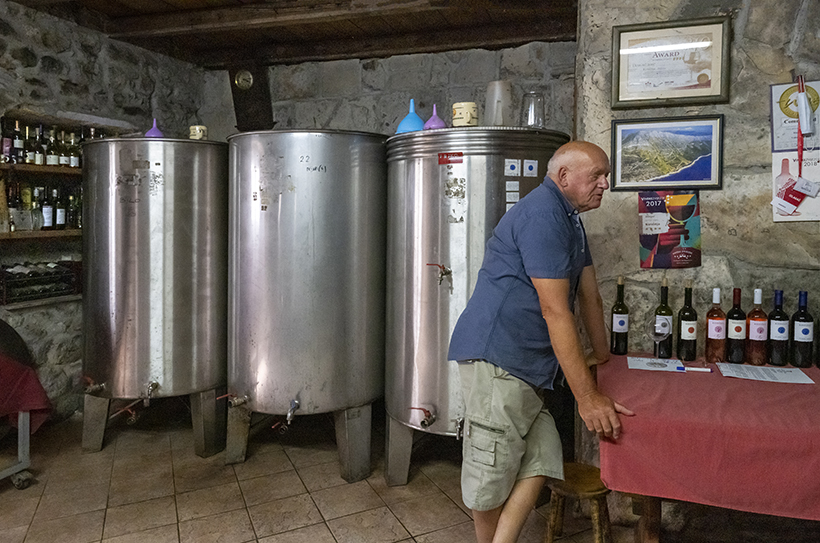
Time to say more about this Plavac Mali I’ve been talking about so much. A cross between Zinfandel and Dobričić grapes, this is the primary red varietal grown along Croatia’s Dalmatian coast. The name refers to its small blue grapes: in Croatian, plavi means blue, and mali means small. Plavac Mali produces full-bodied wines that can reach high alcohol levels and are often characterized by a nose of berries, pepper, and spices. This is the predominant varietal on the Pelješac peninsula. Every once in a while, you’ll see a producer blend it with some French Marselan, like in the Di-Mare. You’ll also see white made with Rukatac, but many wineries prefer purchasing Pošip grapes from the nearby island of Korčula. Plavac is the grape Pelješac is famous for, and it shows immediately in the wines on display. Matković, for example, produces one Rukatac, one Marselan, and five wines with Plavac: Plavac, Plavac Barrique, Dingač, Di-Mare, and a red prošek they call Tezoro Nero. Excluding that super-limited Rukatac prošek, which they mostly keep for family and friends, I believe that Kiridžija vinifies only Plavac Mali: one rosé and three reds, including one Dingač. You’ll soon see that the other wineries are no different. The best Plavac Mali on the peninsula is grown on the stony southern coast, where arid conditions and salty breezes produce more concentrated vines.
Which brings us to the Dingač microregion, an approximately 8-kilometer long and 1-kilometer wide strip of land on the southern coast, between Podobuče and Trstenik, separated from the Northern part of the peninsula and the winemaking village of Potomje by a mountain ridge, and descending steeply towards the sea.

As shown in the satellite view, Dingač is a secluded area. It doesn’t harbor fancy hotels or restaurants, just a handful of tiny villages by the sea, one of which is also called Dingač. The shore is mostly rocks and there are very few beaches. You can only get there by small roads following the coastline, or from Potomje via a one-lane, 400-meter long tunnel through the mountain, whose construction was financed by winemakers in 1973 in order to be able to transport their grapes more easily. Before the tunnel, donkeys were used to carry the harvest over the 400-meter high hills. (I hear that animals are still used in the vineyard areas too steep for tractors.) At first barely more than a hole punched through the rock – see photo taken in the early days – the tunnel has been modernized but remains a breathtaking way to be introduced to the area, like a conduit to a different world. Interestingly, because Potomje is on a kind of plateau, you emerge on the coastal side not at sea level, but halfway up the slope.
Dingač is protected from northern winds by mountain ranges, which keeps the air temperature higher than on the rest of the peninsula in winter. The vineyards are planted from sea level up to 300 m altitude and facing southwest. This provides them with a triple dose of heat:
- direct sunlight (2,800 hours of sunshine annually, with limited precipitation), intensified by an incline ranging from 10 to 60 degrees
- reflected sunlight from the sea
- reflected light and heat from the white rocks surrounding the vineyards and in the soil
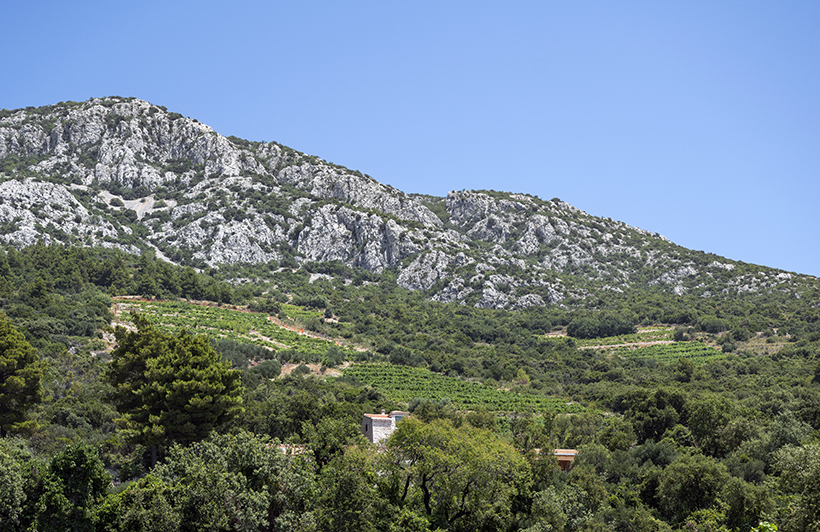
The terroir consists of pebble deposits on the karst substrate formed from the dissolution of soluble rocks such as limestone. The soil is about 75% pebbles and 25% of sand, dust, and clay, making for a very permeable surface that optimizes heat regulation at ground level. A high concentration of potassium, which promotes root growth and fruit size, plays an important role in the quality of the wines. The vine roots reach depths up to 10 meters to draw nourishment and hold strong against the harshest conditions, even in severe drought periods. During heavy rainfalls, the incline and permeability create natural drainage. In order to protect the soil from erosion, the locals have built terrace walls (called suhozidi in Croatian) using stones taken from the slopes.
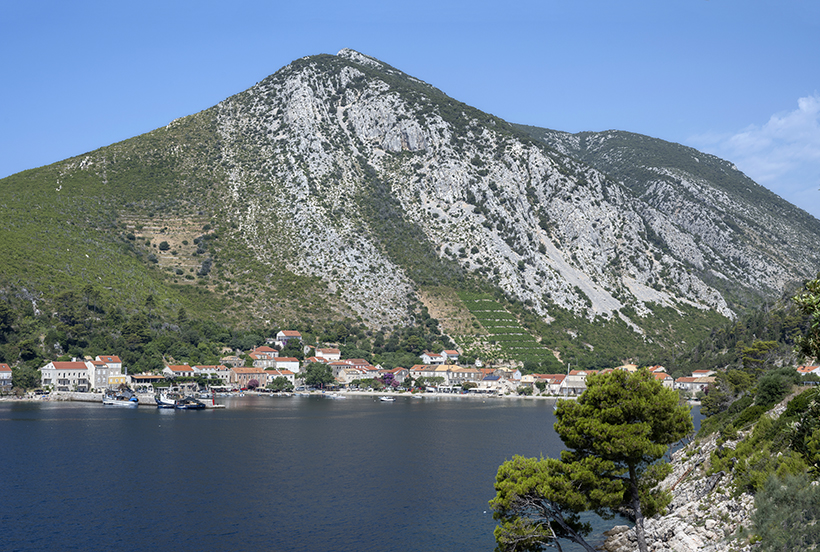
This combination of soil composition, exposure, and climate is what makes Dingač an outstanding growing region. The wines have been renowned for their quality for centuries, and Dingač was officially recognized as Yugoslavia’s first protected wine appellation in 1961. While private winemaking wasn’t allowed at that time, demand in Yugoslavia and abroad for Plavac Mali from the Dingač microregion was very high and resulted in many counterfeits. A decree from the Ministry of Agriculture declared that only the Dingač Agricultural Cooperative, located in Potomoje, could produce wines under the name Dingač. Transition to a market economy put an end to the state monopoly, and I hear that the cooperative was derelict for a while. But it then resumed operation and is still active to this day. Its massive steel tanks basking in the sun can be seen not far from the Dingač tunnel, near the Matuško winery.
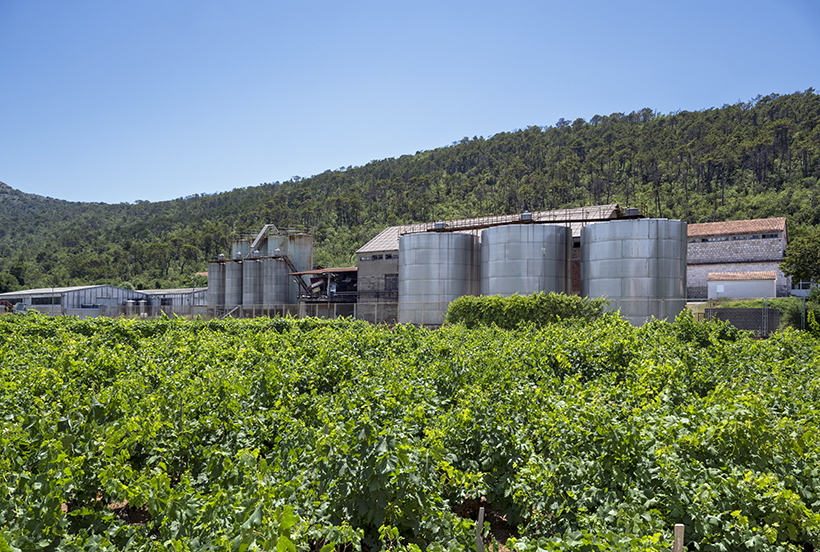
Today, the area boasts a European Protected Designation of Origin (the registration document and specs in Croatian are available here). To bear the Dingač appellation on its label, a wine must contain 85% or more grapes from the Dingač microregion. An additional denomination of “Klasiko” (classic) means that the wine was maturated for at least 12 months – at least 9 in a wooden barrel and 3 in the bottle – while “Riserva” (reserve) is used for vintages that were matured for at least 24 months – at least 18 in a wooden barrel and 6 in the bottle. Officially, the wines are of a dark ruby red color, sometimes with a purple hue, and exhibit the distinctive smell of the Plavac Mali variety: a nose of prunes and dried figs, and the retronasal aroma of freshly baked bread. They boast a rounded, slightly astringent taste with an emphasis on freshness, and become fuller and more robust with age.
With about 60 hectares of vineyards, Dingač produces 2,000 to 3,000 hectoliters of wine. Generally, the higher the field, the lower the yield, because the grapes receive so much heat that they dry on the vine. These dried fruits produce the most concentrated and sought-after wines, and can result in an alcohol content so high that it kills the yeast and leaves some residual sugar. Matuško winery (more on them next time) offers several examples of this.
Very few producers have tasting rooms on the Dingač slopes proper. I imagine that some villagers have their own artisanal production, but commercial wineries tend to set up their operations outside of the protected area, in Trstenik, Potomje, other inland villages, or in the more touristy Orebić. On our adventure, we do drive past (and stop by) the house of the Daničić-Kačić family, who own a winery in Potomje but also keep a cute little wine shop in what looks like a converted basement garage. Once again, most of the labels say either Plavac Mali or Dingač. We taste the wines without much ceremony and soon leave with a couple of bottles. Do they stand up to the big names? You’ll find out in a later post. For now, all I can tell you is that the owners don’t live on a dead end street, don’t stare at you with a confused look, and do speak English. So get off the beach and pay them a visit during your next vacation!
